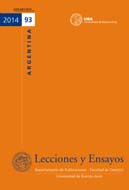Collision of Rights Surrounding Fracking: The 'Vaca Muerta' Conflict from the Perspective of the National Constitution
Keywords:
ypf, hydrocarbon, fracking, national constitution, vaca muertaAbstract
A normative conflict occurs when in one same legal system there are two or more rules that facing the same factual situation establish incompatible juridical consequences. Imagine the dimension that would have the conflict if the interests in dispute are the right to life, the right to a healthy environment or the right to free enterprise. Now add that the conflict is related to the shale gas and shale oil exploitation and there we have an overview of the topic that motivates these lines. The exploitation of that resource has been in the latest news because of the decision of exploiting a big reserve located in Neuquén, called “Vaca Muerta”, where 8 km. away from it lives a “mapuche” community, which has been extremely affected by the oil activity and sadly famous because of police brutality suffered in the doors of the provincial legislative assembly during the debate on the agreement Neuquén-YPF. This work tries to find a solution to this conflict from a constitutional perspective.
Downloads
References
BACCHETTA, Víctor L., “Geopolítica del fracking. Impactos y riesgos ambientales”, en DETCH, Claudia (dir.), Revista Nueva Sociedad, ¿Emancipación o dependencia? Los recursos naturales en América Latina, n° 244, Buenos Aires, 2013.
BALAZOTE, Alejandro O., “Efectos socioambientales de la explotación gasífera y petrolífera en la cuenca neuquina”, en Cuadernos de Antropología Social. Instituto de Ciencias Antropológicas. Facultad de Filosofía y Letras, Buenos Aires, EIP, UBA, 1998.
BALAZOTE, Alejandro O. y RADOVICH, Juan C., “Inversión de capital y riesgo en grupos mapuche asentados en el yacimiento de Loma La Lata”, en TRINCHERO, Héctor H. y BALAZOTE, Alejandro O. (comp.), Etnicidades y territorios en redefinición. Perspectiva histórica y antropológica (Estudios desde la realidad argentina), Córdoba, Universidad Nacional de Córdoba, 2000.
BELOUSOV, Vladímir, Geología Estructural, Moscú, Editorial Mir, 1974.
BIDART CAMPOS, Germán J., “La Constitución Económica (un esbozo desde el derecho constitucional argentino)”, en Cuestiones Constitucionales, n° 6, México, Universidad Nacional Autónoma de México, 2002.
——, Manual de la Constitución Reformada, Buenos Aires, Ediar, 2006.
BORÓN, Atilio, Tras el búho de Minerva, Buenos Aires, Fondo de Cultura Económica, 2000.
CAPELLA, Juan R., Los ciudadanos siervos, Madrid, Trotta, 2005.
CASSAGNE, Juan C., Tratado de Derecho Administrativo, Buenos Aires, Abeledo-Perrot, 2002.
CORTI, Horacio, Derecho Constitucional Presupuestario, Buenos Aires, Lexis-Nexis, 2007.
FRALLICCIARDI, Bartolomé, Teoría de la organización y Administración Pública, Buenos Aires, Cathedra Jurídica, 2012.
GIBBS, John F., et. al., “Seismicity in the Rangely, Colorado, area: 1962-1970” en Bulletin of the Seismological Society of America, n° 63, California, 1973.
GORDILLO, Agustín, Tratado de Derecho Administrativo, Buenos Aires, Fundación de Derecho Administrativo, 2009.
GUILLEMOT, Christian J., Geología del petróleo, Madrid, Ediciones Paraninfo, 1982
HÄBERLE, Peter, “Siete tesis para una teoría constitucional del mercado”, en Revista de Derecho Constitucional Europeo, n° 77, Andalucía, Instituto Andaluz de Administración Pública, 2006.
——, Nueve ensayos y una lección jubilar, Lima, Asociación Peruana de Derecho Constitucional, 2004.
HECHEM, Jorge J., “Breve Historia sobre el Descubrimiento Loma La Lata”, en Petrotecnia Revista de Divulgación de Instituto Argentino del Petróleo y del Gas, n° 2/10, Buenos Aires, Instituto Argentino del Petróleo y del Gas, 2010.
HOFER, María I., La contaminación de las aguas desde la óptica del Derecho, Buenos Aires, Del País, 2006.
KIM, Won Y., “Induced seismicity associated with fluid injection into a deep well in Youngstown, Ohio”, en Journal of Geophysical Research: Solid Earth, vol. 118, Malden, 2013.
ORWELL, George, Rebelión en la granja, Buenos Aires, Booket, 2007.
PÉREZ ROIG, Diego, Hidrocarburos no convencionales en Argentina, consultado en [http://opsur.wordpress.com/2011/11/17/hidrocarburos-no-convencionales-en-argentina/].
SAID, José L., “Responsabilidad del Estado y Justicia Distributiva”, en Revista Argentina del Régimen de la Administración Pública (RAP), n° 370, Buenos Aires, 2009.
GONZÁLEZ, San Román, et. al., Geología del Petróleo, La Habana, Centro Politécnico del Petróleo, 2007.
TAILLANT, Jorge D., et al., Fracking Argentina, Informe Técnico y Legal sobre la Fracturación Hidráulica en Argentina, consultado en [http://wp.cedha.net/wp-content/uploads/2013/10/Fracking-Report-CEDHA-final-24-oct-2013-SPANISH.pdf].
TURIEL, Antonio M., Fracking: rentabilidad energética, económica y ecológica, consultado en [crashoil.blogspot.com.ar/2013/02/fracking-rentabilidad-energetica.html].
VILLEGAS BASAVILBASO, Benjamín, Derecho Administrativo, Madrid, TEA, 1952.
WEAVER, Charles E., “Paleontology of the Jurassic and Cretaceous of West central Argentina”, en American Journal of Science, vol. 1, Memoirs n° 22(128), Washington, University of Washington, 1931.
GASLAND (2010), dirigida por Josh Fox.
LA GUERRA DEL FRACKING (2013), dirigida por Pino Solanas.
Published
How to Cite
Issue
Section
License

This work is licensed under a Creative Commons Attribution-NonCommercial 4.0 International License.











